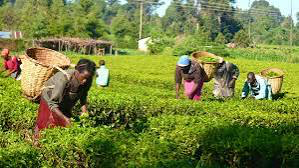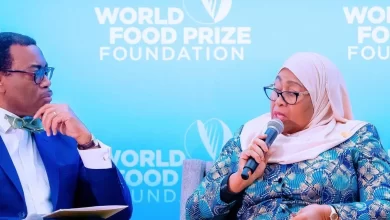Why Agriculture Is Key To Sustainable Development

By Prince S.J. Samuel
At the root of every developmental initiative lies the importance of promoting the well-being of the people in the general sense. Tangential thoughts to this suggest that there must be absolute focus on housing development, investment in science and technology, healthcare, education, provision of infrastructure (roads, rail system, seaport, airport, internet services via provision of low-cost penetration of broadband) and the likes. However, the primacy of provision of food in a sustainable fashion to meet the yearning nourishing need of that populace remains a key kernel of that well-being which necessitates the focus on Agriculture.
Agriculture at the Heart of the 2030 Agenda
The 2030 Agenda for Sustainable Development is a detailed framework that was adopted by United Nations member states in 2015 to tackle global challenges and ensure sustainable development across economic, social, and environmental aspects. This agenda consists of 17 goals encoded in the Sustainable Development Goals (SDGs) Agenda and 169 targets aimed at eliminating poverty, promoting equality, safeguarding the planet, and encouraging peace and prosperity for everyone. So, the initiative serves as a universal call to action to end poverty, protect the planet, and ensure prosperity for all by 2030 through an integrated approach that addresses multiple dimensions of sustainable development.
Furthermore, the 2030 Agenda acknowledges that food, livelihoods, and natural resources management must be considered as interconnected elements. Prioritising rural development and investing in agriculture, including crops, livestock, forestry, fisheries, and aquaculture are essential steps to help eradicate poverty and hunger while also promoting sustainable development.
Additionally, agriculture plays a crucial role in addressing climate change and its attendant effects. The journey from ending poverty and hunger to responding to climate change and sustaining our natural resources, food and agriculture lie at the very heart of the 2030 Agenda for sustainable development and are primed to help meet the entire set of goals of the SDG initiative.
The Urgency of the Need
In 2023, around 2.33 billion people globally faced moderate or severe food insecurity, a number that has not changed significantly since the sharp upturn in 2020, amid the COVID-19 pandemic. Among those, over 864 million people experienced severe food insecurity, going without food for an entire day or more at times as highlighted by the World Health Organization (WHO).
Also, according to a report by Food and Agriculture Organization (FAO) in 2022 indicates around 258 million people across 58 countries and territories faced acute food insecurity at crisis or worse levels (IPC/CH Phase 3-5), up from 193 million people in 53 countries and territories in 2021. The Global Report on Food Crises (GRFC) 2023 accentuates similar outcome by noting that the number of people experiencing high levels of acute food insecurity and requiring urgent food intervention and livelihood assistance increased for the fourth consecutive year in 2022.
Furthermore, the annual report, launched in July 2024, in the context of the G20 Global Alliance against Hunger and Poverty Task Force Ministerial Meeting in Brazil, warns that the world is falling significantly short of achieving SDG 2 target of Zero Hunger by 2030. It further alerts relevant global bodies such as the FAO, the International Fund for Agricultural Development (IFAD), the United Nations Children’s Fund (UNICEF), the World Food Programme (WFP), and the WHO that if the current trends continue, about 582 million people will be chronically undernourished in 2030, and regrettably, half of them will be in Africa.
The indicators
According to the UN, the world population is projected to reach up to 9.8 billion by the year 2050. Consequently, there will be two billion more people to feed by mid-century and this would require a significant increase of around 60% in global food production to feed the world. The global system will have to find a way to fund this demand.
Agriculture: The Way out of the Woods
In 2021, data from the World Bank Group shows that agriculture employed over 800 million people, representing 27% of the global workforce. Agriculture can help reduce poverty, raise incomes and improve food security for 80% of the world’s poor who live in the rural areas and whose mainstay is agriculture.
The U.S. Department of Agriculture (USDA) Economic Research Service reports that the agricultural and food sectors provided 10 per cent of all U.S. employment in 2020 — nearly 20 million full and part-time jobs. In addition, it was reported that cash receipts from crops and other agrarian-related activities chalked up nearly $198 billion, while animal products reached $165 billion. As a critical factor for economic growth, the World Bank, in a 2023 report asserts that agriculture accounts for 4% of global GDP.
Agriculture and food-related industries contributed roughly $1.530 trillion to the US economy in 2023, representing 5.6% of the GDP. The output of America’s farms contributed $203.5 billion of this sum, about 0.7% of the US GDP. The overall contribution of agriculture to GDP is larger than 0.7% because sectors related to agriculture rely on agricultural inputs to add value to the economy. In 2022, 22.1 million of both full-time and part-time jobs were related to the agricultural and food sectors—10.4% of of the employment data in the U.S. employment. (USDA).
In Europe, agriculture contributed 1.3% to the EU’s GDP in 2023. Although the sector represents a small share of the EU’s economy, it contributed €215.5 billion to the GDP in 2022, accounting for 1.4% of total GDP, a proportion that has remained stable over the past 20 years (Eurostat).
Thriving on the Back of Agriculture
Agriculture influences society in numerous ways, such as sustaining livelihoods by providing food, creating habitats, and generating employment opportunities. It also supplies essential raw materials for food production and various other goods, while contributing to the development of robust economies through trade activities.
Countries that experience growth in agricultural productivity and possess strong agricultural infrastructure tend to have higher per capita incomes. This is because producers in these nations leverage technology and improved farm management practices to enhance both agricultural productivity and profitability. These nations play a crucial role in sustaining the world’s population by providing a significant share of the overall food supply.
China
China’s population represents approximately 18% of the global population. China possesses 10% of the world’s total arable land, yet it sustains over 20% of the global population. The country’s total food production has reached 687 million tons, maintaining a level above 650 million tons for eight consecutive years. Within this total, grain production stands at an impressive 633 million tons, which constitutes nearly 23% of the world’s overall grain output. China’s landmass and economy occupy approximately 55% of its landmass and contribute to over 12% of the global GDP. In addition, around 50% of its workforce is engaged in agriculture.
In 2023, China’s total grain production reached 695.41 million tons (equivalent to 1,390.8 billion jin), marking an increase of 8.88 million tons (or 17.8 billion jin), which represents a growth of 1.3% compared to the figures from 2022. In breakdown, China’s exports of agricultural products increased 0.9 % year-on-year to 98.93 billion dollars, while its imports dipped 0.3 % to 234.11 billion dollars.
The United States
The U.S. is the world’s largest country by landmass and a net exporter of food, contributed by the agricultural sector. Due to mechanised farming, the US is the leader in crop production and seed improvement. Twenty-three per cent of the exported products in the USA are obtained through agriculture. The U.S. agricultural exports have experienced consistent growth over the last 25 years, culminating in a total of $174 billion in 2023, compared to $57.3 billion in 1998.
Throughout this quarter-century period, the composition of these agricultural exports has evolved, mirroring shifts in global supply and demand dynamics. In 2023, agriculture, food, and associated industries accounted for approximately $1.530 trillion of the U.S. gross domestic product (GDP), representing a share of 5.6 %. Of this total, the output from American farms contributed $203.5 billion, which is around 0.7 % of the overall U.S. GDP
Brazil.
Brazil stands as a significant agricultural and industrial powerhouse, recognized as the leading economy in Latin America and the Caribbean. The country excels in the production of various commodities, including coffee, sugarcane, soybeans, beef, and poultry. Notably, Brazil has achieved remarkable advancements in poverty alleviation, reducing the poverty rate from 64 % in 1990 to 28 % by 2021.
The Center for Advanced Studies on Applied Economics at the University of São Paulo has estimated that when factoring in activities such as processing and distribution, the agriculture and food sector in Brazil constitutes 29 % of the nation’s GDP, which was valued at $1.8 trillion in 2021. In 2023, Brazilian agribusiness exports reached an unprecedented level, totaling US$ 166.55 billion.
This figure marks a 4.8% increase compared to the previous year, translating to an additional US$ 7.68 billion in export value. Agribusiness represented a significant portion of Brazil’s overall export activity, accounting for 49% of total exports in 2023, up from 47.5% in 2022. In 2023, Brazil emerged as the foremost exporter of ten key agricultural products globally. These commodities included soybeans, soybean meal, corn, sugar, coffee, orange juice, beef, poultry, tobacco, and cellulose. The country experienced a significant increase in protein exports during this year; specifically, pork exports rose by 9.2%, while poultry exports increased by 7.7%, and beef exports saw a growth of 1.2%.
India
India is presently the second largest global producer of various dry fruits, textile raw materials derived from agriculture, root and tuber crops, pulses, aquaculture fish, eggs, coconuts, sugarcane, and a wide array of vegetables.
According to the Economic Survey 2022-23 presented in Parliament by Union Minister of Finance and Corporate Affairs Smt., India’s food grain production reached a record high of 315.7 million tonnes in the 2021-22 period, despite facing challenges posed by climate change. The present contribution of agriculture to India’s GDP is approximately 18-19%. The most recent estimates for the fiscal year 2022-23 indicate that the Gross Value Added (GVA) from agriculture and related sectors accounts for 18.3% of the overall Indian economy.
Despite a decrease in its agricultural exports in 2023, which fell to $51 billion from $55 billion in 2022, India retained its status as the world’s eighth-largest exporter of agricultural products. This was noted as seven of the top ten exporting countries also experienced a decline, according to data compiled by the WTO.
In the final quarter of 2023, India’s agriculture sector contributed over 7 trillion Indian rupees to the nation’s GDP. This marked a notable increase compared to the contribution in the third quarter. The agriculture sector’s contribution typically follows a cyclical pattern, with the fourth quarter being the strongest period of the year.
Time to Roll Up the Sleeves
As the 2030 Agenda for Sustainable Development acknowledges the critical role that agriculture will play in achieving the highlighted line items of the agenda, the universal call to action to end poverty and ensure prosperity for all cannot be over-emphasised. Therefore, prioritising rural development through deliberate investment in agriculture remains an essential strategy for eradicating poverty and hunger while promoting sustainable development.
Relevant government agencies across the world and international organizations including the Food and Agriculture Organization (FAO), the International Fund for Agricultural Development (IFAD), the United Nations Children’s Fund (UNICEF), the World Food Programme (WFP), and the World Health Organization (WHO) must collaborate and mobilise adequate resources to speed up every action in this regard.
Prince S.J. Samuel is the Chairman, Origin Tech Group





